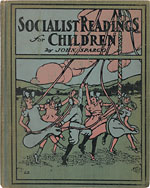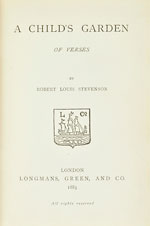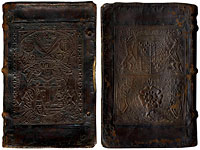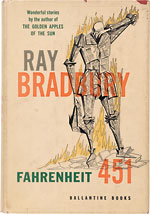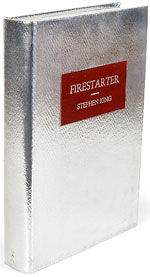Autumn Auctions, Featuring Apple Cider, Books for Children, Fire and Leaves
Read by Reds under the Bed
Socialist Readings for Children, PBA Galleries San Francisco on October 1, $180
John Spargo’s Socialist Readings for Children was one of a number of works written by members of the Socialist Party of America. Published in New York in 1909 for The Woman’s National Progressive League, the book was intended for use in Socialist Sunday schools across the country.
Illustrated by Edward Scholl, one of whose contributions features on the decorative cloth cover seen here. Unfortunately, the copy offered at this California saleroom was faded to the spine and cracked at the front hinge, but it sold for $180. The fact that it bore the bookplate of the U.S. railroad baron E.H. Harriman–father of politician and diplomat William Averell Harriman–may have helped.
The term socialist has rather different connotations in the U.S. than in Europe. I was amused to see that the only bibliographical reference offered by the auctioneers was to Paul Mishler’s Raising Reds, a Columbia University Press book published in 1999 that is sub-titled “The Young Pioneers, Radical Summer Camps, and Communist Political Culture in the United States.”
Stevenson’s Farewell to a Lost Child
A Child’s Garden of Verses, Swann New York on October 1 ($1,680) & Dominic Winter South Cerney on September 23 ($7,285)
The socialist youth primer featured above was sandwiched in the New York catalogue between firsts of books of much greater appeal to little folk – Beatrix Potter’s The Tale of Tom Kitten and Robert Louis Stevenson’s A Child’s Garden of Verses. The 1885 first issue of the latter sold at $1,680 in New York, but another copy of Stevenson’s charming collection of verses realized a much higher price at the Dominic Winter sale.
First issue copies are distinguished by having the apostrophe properly in place and a smaller type ‘of’ on the gilt-lettered spine title, though some salesrooms continue to describe this form as a variant binding. The example in the English sale was one of the 1,000 copies of that 1885 first issue. Though slightly rubbed and showing some marginal discolouration and browning to the endpapers, it was generally a very fine copy. It was given a mystifyingly low estimate of £200-300 but was contested by two collectors and sold for a whopping £4,583 ($7,285).
Only one copy has brought more at auction, but that one, sold for $9,900 as part of the Richard Manney Library at Sotheby’s New York in 1991, was one that Stevenson had inscribed as a gift to a godchild. Tragically, the child died before the book arrived. Just days later, on the back of the advertisement leaf, Stevenson added a poem for the grieving parents.
Before this little gift was come
The little owner had made haste for home;
And from the door where the eternal dwell,
Looked back on human things and smiled Farewell.
O may this grief remain the only one!
O may your house keep still a garrison
Of smiling children and forevermore
The tune of little feet be heard along the floor!
Adventures with Archbishop Cranmer
Herodian’s Greek History, Bonhams London on October 6, $19,080
Those who purchased the catalogue for the sale of the library of bookdealer Richard Hatchwell also received a copy of Adventure, a selection of his bibliographical and dealing reminiscences. Among books and special items singled out for mention was his copy of a 1529 Paris printing by Simon Colines of Herodian's Historici graeci.
“I was shopping in Bath one morning when I remembered there was a sale at Phillips…I had a few minutes to view before the sale. There was only one lot that drew my attention, a small group of three 16th century books. Two were of no great consequence, but the third was in a good, well-preserved English stamped binding by John Reynes of London, on an edition of Herodian, Paris 1529. When I opened the book at the top of the title-page was the inscription Thomae Cantuarensis, i.e. Thomas of Canterbury, i.e. Thomas Cranmer.
Now this was not mentioned in the catalogue but I recognised it immediately as I had been in correspondence with David Selwyn not long before, concerning another book from Cranmer’s library…Fortunately nobody else noticed the inscription and I was able to buy the lot for a very modest sum.”
Few books from the library formed by Henry VIII’s Archbishop of Canterbury have survived in original bindings, and while this one is not listed in Selwyn’s 1996 study, The Library of Thomas Cranmer, he does list two others in bindings by John Reynes. The fact that the pictorial panel stamped on the lower cover is in the second state, with Katherine of Aragon’s pomegranate emblem replaced by Henry VIII’s cockerel, led Bonhams to date the binding to around 1531, when Katherine was expelled from Henry’s court. It sold to UK dealers Sims Reed at £12,000 ($19,080).
Book Burning for Beginners
Fahrenheit 451, Swann New York on October 1, $3,120 & $7,800
Firestarter, Bonhams Los Angeles & New York on October 19, $7,930
Ray Bradbury always maintained that his science fiction classic about book burning, Fahrenheit 451, was not about government censorship, as generally believed, but was inspired by a belief that television was destroying the reading habit. But people still read Bradbury, and no one is likely to burn a first of Fahrenheit 451. In certain cases they would be effectively prevented from doing so.
Expanded from a 1951 novella called The Fireman, the book was first published by Ballantine of New York in 1953. At the Swann sale, an exceptional trade first was bid to $3,120. True, the jacket was slightly worn, soiled, and chipped, but Bradbury had both signed it and sketched a caricature of himself smiling as he is consumed by flames. The Swann sale also saw $7,800 paid for one of copies of Ballantine’s limited edition first of the same year. These special copies were illustrated by Joe Muganini and bound in a red-lettered, white asbestos-based material. Signed and inscribed, this particular copy was given to Bradbury’s longtime publisher at the Lord John Press, Herb Yellin: “For Herb, this asbestos-bound first edition of F.451 – with good wishes Ray Bradbury.”
An asbestos binding was a publishing experiment that seemed unlikely to be repeated, but in honor of the asbestos version of Bradbury’s book, the Phantasia Press produced 26 lettered copies of Stephen King’s second novel, Firestarter, bound in aluminum-coated asbestos in 1980. Copy ‘B’ at Bonhams was bid to $7,930.








 Ian McKay’s weekly column in Antiques Trade Gazette has been running for more than 30 years.
Ian McKay’s weekly column in Antiques Trade Gazette has been running for more than 30 years.